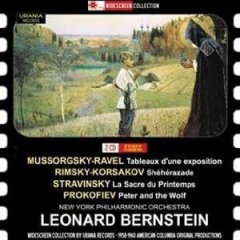Stravinsky - Le Sacre du Printemps (Bernstein NYPO) [2010]
Stravinsky - Le Sacre du Printemps (Bernstein NYPO) [2010]

1 Introduction (Lento) 3:27 2 Les Augures Printaniers. Danses Des Adolescentes 3:15 3 Jeu Du Rapt 1:21 4 Rondes Printanières 3:48 5 Jeux Des Cités Rivales 1:56 6 Cortège Du Sage 0:43 7 Adoration De La Terre - Le Sage 0:22 8 Danse De La Terre 1:12 9 Introduction (Largo) 5:28 10 Cescles Mystérieux Des Adolescentes 3:50 11 Glorification De L'Élue 1:40 12 Évocation Des Ancêtres 0:55 13 Action Rituelle Des Ancêtres 4:13 14 Danse Sacrale. L'Élue 4:46 New York Philharmonic Orchestra Leonard Bernstein – conductor
In his attempt to continue to represent his fascination with Slavic folklore, Igor Stravinsky premiered his third successive ballet, Le Sacre du printemps (more commonly referred by its English translation “The Rite of Spring”) in the late spring of 1913. Like The Firebird and Petrushka ballets before it, Rite is founded upon the neoclassical terrain that was still fairly early in formation during the early part of the 20th century. In these two works, Stravinsky began distancing himself from conservative musical understandings, creating new inventions to express his colourful atonal aspirations. His radical innovations led to new ideas sprouting into improvements on the quality of dissonance and rhythm combined.
His experimentations eventually paved the way to his preliminary sketches for Rite on the pianoforte. Simply how one could possibly condense such a large scale of compositional material into one instrument is still beyond many. The backbone vertebrae (girders, if you like) are made of melodic asymmetry (micro and macro), colourful accentuation and articulation (melodic and harmonic), and complex rhythmical fluctuations. All of these ideas were already tried and tested in former works by others, but in a conservative fashion. Here, Stravinsky uses them as the sole chassis for work, setting it apart from all other investigations thus far. Despite its apparent intense complexity, Rite is completely listenable, and not as mechanical as its score sometimes suggests.
In two parts, the score delves between dense and sparse orchestration. Unlike many other works for large orchestra, Stravinsky uses each instrument from its lowest to highest range, and plays with the instrumentalist’s skill from undemanding melodies, to obscure cross hashes of polyrhythms. The first part “Adoration of the Earth” initiates the work through an ominous bassoon melody, which he returns to on many occasions throughout the number. It’s fairly simple, yet distinct, and clear amid the clouded accompaniment of dissonant layers from other instruments. The introduction, which lasts a little under four minutes, could be sampled as what the rest of Rite offers in terms of surprise and joy. However, as the lasting plucked notes of the violins stretch to a point of uncertainty, the full orchestra engages in a violent mash of heavy off-beat brass accentuation, known as “Dance of the Adolescents”. From here the score flows in and out of remaining ideas which were first introduced in the introduction, but they are presented alongside clever accompaniment to maintain a devout interest from the audience, giving a more subdued quality, before returning to percussive chaos, back again to beauty and so forth.
While nowadays we can comfortably denote that Rite is impressive in both its composition and style, back in 1913 during its premiere, many of the revolutionary ideas were swallowed with bitter reluctance. It only took the opening notes from the bassoon to dishearten attendees (even some renowned composers), some leaving before anything had even begun. It’s somewhat of a good thing they did. Barely into the performance, had the audience completely polarised between admiration and hatred for the work. Fistfights endured in walkways, demoralizing verbal remarks were exchanged between members in the box houses, leading to Stravinsky fleeing for his safety amid the riot. Never had such an event given way to such public disapproval, both emotionally and physically. Although the audience was having its own ‘performance’ at the time, the orchestra and dance act maintained their presentation, only ceasing between movements.
By the time the performers arrived at the second part, the audience had managed to be restrained to allow seamless continuation. The second section itself, “The Sacrifice” is no less enjoyable then the first. Similarly it makes use of distinct symmetrical melodies and asymmetrical rhythm. They are used in such a way that maintains the desires of each sense (auditory, and visual). Unlike many ballets of the time, Rite was intended to reflect the primitivist style of a pagan ritual. Thus, the music is accompanied by a similar designed ballet performance. One performer is quoted as saying “Vaslav Nijinsky's shocking choreography was physically unnatural to perform.” Most ballets require the dancers to flow with grace, curvature and elegance – Rite on the other hand scraps most of this convention for contrasting, yet still complimenting choreography.
The Rite of Spring tested the future path of 20th century classical music, and in many ways caused music to deviate its course toward more experimentation from many other composers. While alone its influence designates it as one of the best works to have originated out of this era, the composition alone makes for one of the most intriguing listens of all music. It was further popularised through its fluid adaptation to prehistoric life in Disney’s 1940 Fantasia, and unlike other works, somehow manages to keep its beautiful array of melody, jarring intensity and control by always reminding the audience that its still contemporary and original to this day, for the children watching Fantasia, and the adults who manage to witness the work in its intended place of performance. ---Jake C. Taylor, sputnikmusic.com
download: uploaded yandex 4shared mediafire solidfiles mega zalivalka filecloudio anonfiles oboom
Zmieniony (Niedziela, 18 Maj 2014 11:52)








